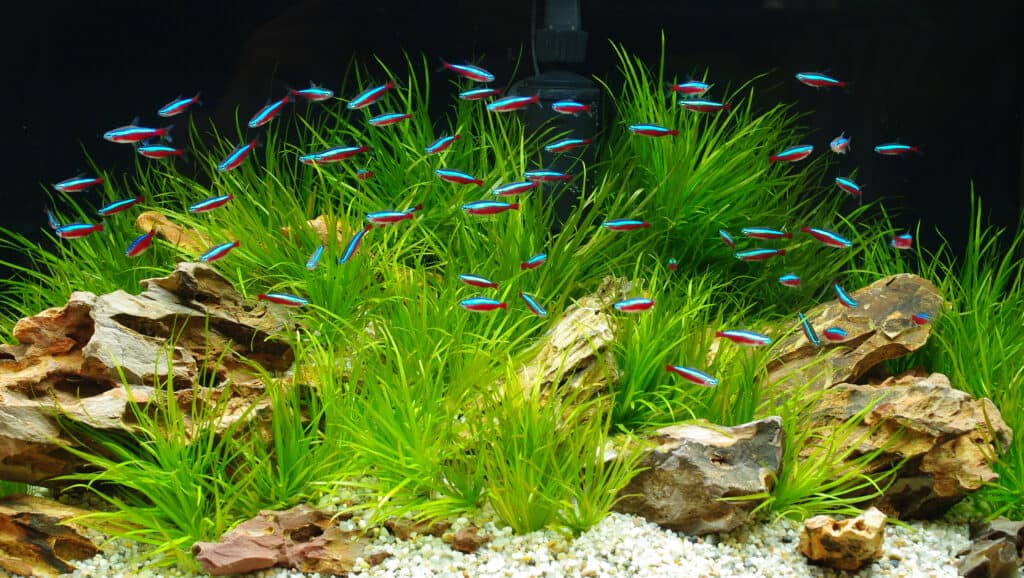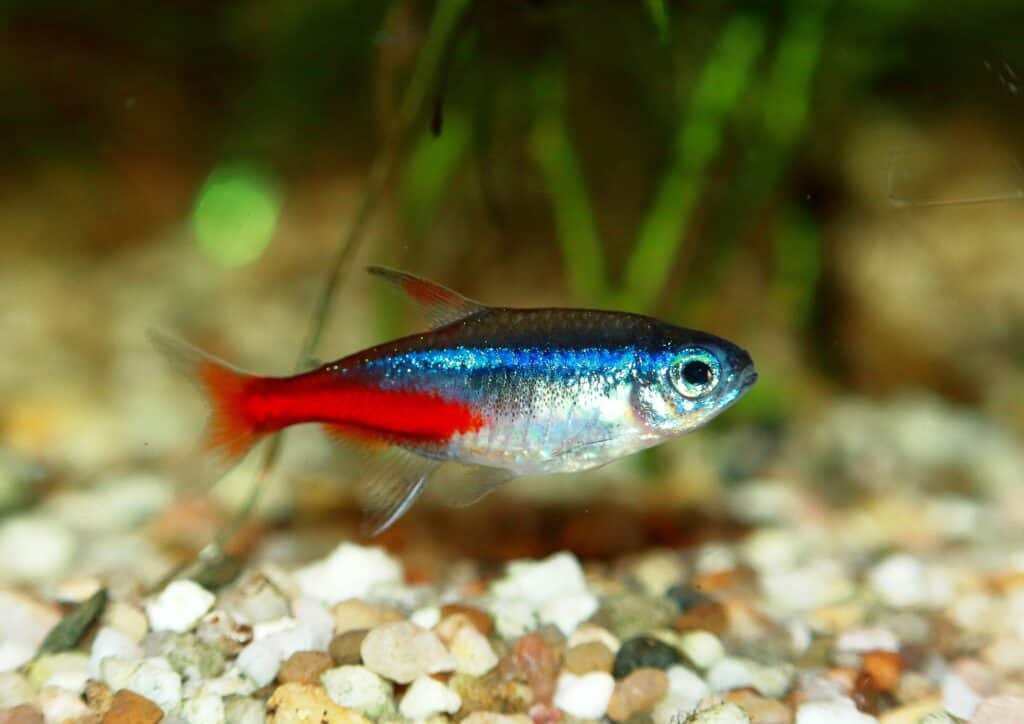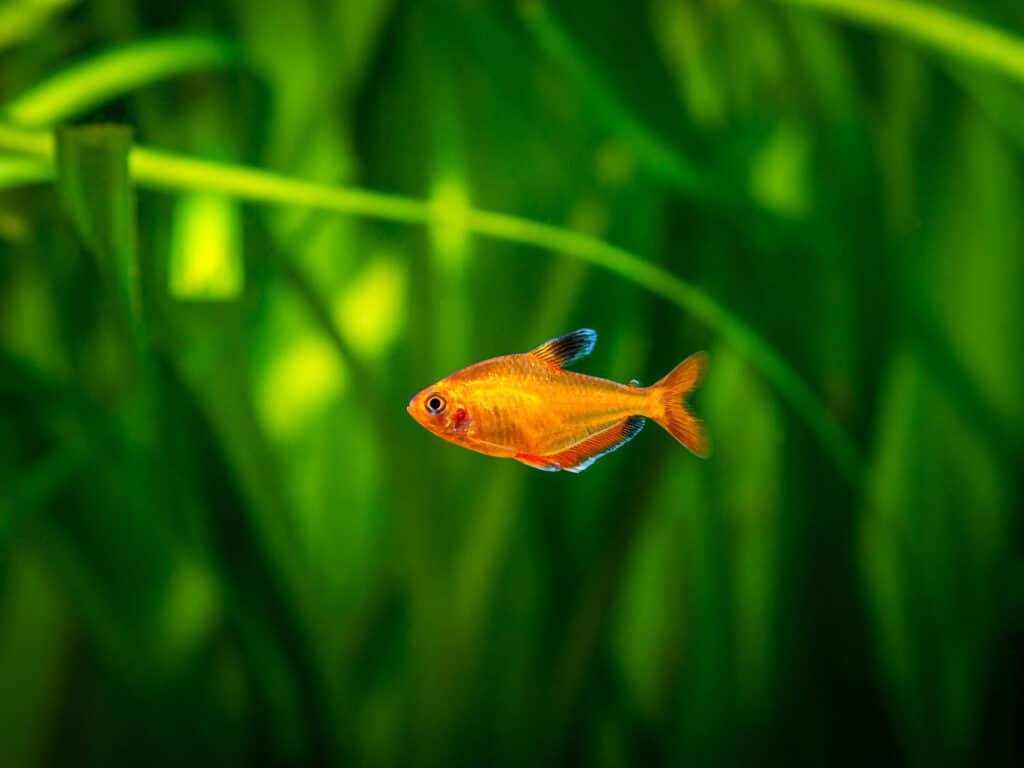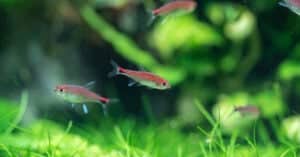Tetras are types of small freshwater fish that are native to tropical South American waters. Some species can be found throughout the Congo River in west-central Africa. There are over 150 species of tetra all belonging to the Chariciformes order. Tetras are one of the most popular freshwater schooling fish in the world. Their popularity is quite high in the aquarium trade industry.
Tetras are relatively inexpensive fish that cohabit peacefully in various types of aquariums. They also happen to be some of the most colorful fish. Alongside their usual peaceful temperaments, they make excellent additions to community aquariums.

If you are looking to purchase a tetra anytime soon, then this article is for you. We cover the expected costs of different tetra species and which factors influence their overall cost.
How Much Do Tetras Cost?
Most species of tetra are relatively inexpensive and cost between $1 to $20. Tetras are common in many pet stores, and often at a low price. Tetras are naturally social fish that need to be kept in groups of six or more to form a school. You will need to purchase multiple tetras of the same species at once. Due to this, some pet stores may sell groups of tetras at a discounted price. You may purchase a group of 10 tetras for the price of eight or six.
Aside from pet stores, tetras are often sold by online retailers or sometimes by fish breeders. However, some species of tetras are more widely available than others. Neon, cardinal, lemon, ember, and black skirt tetras are the most common species of tetras for sale. They are usually stocked by most pet stores and can be purchased in bulk.

Many species of tetras are schooling fish that need to be kept in groups of six or more.
©Dobermaraner/Shutterstock.com
The below table is a breakdown of the costs associated with the most popular tetra species.
| Species of Tetra | Price |
|---|---|
| Neon tetra: | $1 to $3 |
| Congo tetra: | $4 to $10 |
| Lemon tetra: | $1 to $5 |
| Bucktooth tetra: | $5 to $16 |
| Ember tetra: | $2 to $6 |
| Black phantom tetra: | $3 to $5 |
| Diamond tetra: | $5 to $10 |
| Serpae tetra: | $2 to $8 |
| Penguin tetra: | $3 to $10 |
| Columbian tetra: | $1 to $6 |
| Rainbow tetra: | $3 to $20 |
| Rummy nose tetra: | $2 to $8 |
| Flame tetras: | $3 to $10 |
| Bloodfin tetra: | $2 to $5 |
| Cardinal tetra: | $1 to $3 |
| Glowlight tetra: | $2 to $6 |
| Black skirt tetra: | $2 to $5 |
What Is the Cheapest Tetra You Can Purchase?

Neon tetras are small fish at only 1.5 inches long and are recognized by their distinctive neon coloration.
©Kristiana Berzina/Shutterstock.com
The neon tetra is undoubtedly the most inexpensive tetra in the world. Neon tetras are widely available and most pet stores and online retailers stock these small yet vibrantly colored fish. Most neon tetras cost between $1 to $3 per fish, so you can expect to spend around $6 to $18 for a group of six.
4 Factors That Affect the Price of Tetras
When purchasing tetras, there are four factors that can affect their price.
1. Place of Purchase
Tetras are sold around the world by pet stores, online retailers, buy-and-sell websites, and from breeders. However, different places can sell tetras at varying prices. Pet stores and online retailers are more likely to sell tetras for a cheaper and sometimes discounted price. Tetra fish breeders may charge more for their stock since you are likely to get healthier tetras that have been bred for quality rather than quantity.
Furthermore, tetra fish breeders might stock the rarer species of tetra which will affect the price of the tetra.
2. Rarity
While some species of tetras are common in the aquarium trade industry, others are rare. This means that the rarer the tetra is, the more you can expect to pay for them. Some of the most inexpensive tetras like the neon, cardinal, and lemon tetra are affordable because they are not considered rare. They are easy to breed in captivity, widely available, and quite popular amongst fish keepers. However, rarer species like the rainbow and dwarf blue tetra will cost more.
3. Size
Fully grown adult tetras generally cost more than fry or juveniles. This is mainly because tetras are still vulnerable when they are young and small. There isn’t much of a guarantee from the seller that your young tetras will live long enough. Many fish keepers also prefer fully grown tetras over fry or juveniles because you can see the fish much easier in an aquarium. You get to admire their beauty and observe their fascinating behaviors without having to worry about whether your tetras will reach adulthood in your care.
4. Availability
While most species of tetra are widely available around the world, others are not. If a species of tetra is uncommon in a specific location, most sellers will sell the fish for more. This can also influence the tetra’s rarity, and therefore their price.
Important Purchase Consideration
There are certain purchase costs and care aspects that need to be considered before you purchase tetras.
Cost of Tetra Fish Supplies and Tank
| Cost of Supplies | Price |
|---|---|
| Tank: | $20 to $150 |
| Filter: | $10 to $20 |
| Light: | $8 to $20 |
| Substrate: | $5 to $12 |
| Décor and live plants: | $8 to $25 |
| Water treatments: | $5 to $20 |
| Food and supplements: | $3 to $12 |
| Siphon/gravel vacuum: | $10 to $20 |
| Net: | $1 to $2 |
| Bucket: | $1 to $5 |
Tank Size
One of the most important purchase considerations for tetras is their tank size and setup. Although most species of tetra are small at only 1 to 3 inches long, they still need ample space to swim. They also need to be kept in groups of six or more, so a good minimum for the smaller species is 10 gallons.

Different species of tetra will require a different tank size, but at least 10 to 20 gallons is recommended.
©Joan Carles Juarez/Shutterstock.com
The exact minimum tank size for tetras will vary depending on their species. Some tetras are larger and more active than others. A general rule of thumb for tetra tank size is that the more tetras you keep inside, the larger the tank needs to be. You want to avoid keeping any species of tetra in small aquaria like bowls or vases under 10 gallons in size. Most tetras require a rectangular aquarium that offers more horizontal swim space than vertical.
Fortunately, most 10-to-40-gallon aquariums are affordable. You can expect to pay $20 to $150 for a tetra fish tank. In some cases, you might be able to purchase a complete setup at a discounted price. Which includes a hood, light, filter, and heater when you purchase the tank. This could bring the price to around $50 to $200, and you will end up saving money from having to buy those supplies separately.
Tank Setup
Setting up your tetras tank and decorating it is one of the rewarding parts of being an aquarist. You get to choose the plants, décor, and general layout for your tetra’s tank and watch them explore it. The basic setup for most species of tetra is a heater, filter, overhead light, substrate, and live plants.
While you can use fake plants in a tetras tank, live plants are preferred for their benefits. These benefits include oxygenation, and filtration while creating a naturalistic environment for tetras to explore. Many species of tetras benefit from live plants to hide in. This makes them feel more secure than being out in the open. You also have the option of adding rocks and driftwood if they are safe for aquarium use.
The total cost of the supplies needed to set up a tetras tank can vary, but it is usually between $30 to $80.
You will also need to purchase water treatments like dechlorinators and a liquid water testing kit to ensure that your tetra’s water quality is ideal. Aquarium dechlorinators are relatively inexpensive at only $5 to $20, but a liquid water testing kit can cost up to $40.
Compatibility
Most species of tetras are highly social fish that need to be kept in groups of six or more. They should not be kept in pairs or alone since this can be incredibly stressful for them. Aside from needing to be kept in same-specie groups, tetras are compatible with most community aquariums. Tetras can be kept in the same tank as other peaceful, tropical, small fish or invertebrates that thrive at similar water parameters. Some excellent tank mates for tetras include guppies, mollies, Kuhli loaches, bristlenose Plecostomus, and even other species of tetras.
However, not all species of tetras are compatible in community aquariums. The bucktooth tetra is an example of a highly aggressive and territorial species. They are better suited for same-specie aquariums and don’t pair well with most fish. Bucktooth tetras may pick on and chase other fish or try to injure delicate fins.
It is important to thoroughly research the species of tetras you plan to keep to find out which tank mates they are most compatible with.
Diet
Many popular species of tetra are omnivores. They eat a varied diet consisting of plant and animal-based ingredients in the form of a pellet, granule, or flake commercial food. You ideally want to feed them foods that are specifically formulated for tetras, since it is guaranteed to contain all the nutrients they need to stay healthy.

The bright colors of the ember tetra make them desirable fish to keep in aquariums.
©nektofadeev/Shutterstock.com
Most tetra fish foods are inexpensive and cost between $5 to $20. The higher quality of the food, the more you are likely to spend on it. However, it is better to purchase high-quality tetra food rather that has beneficial ingredients and few harmful additives or unnecessary fillers.
Tetras can also benefit from dietary supplements one to four times a week. You can offer them small live or freeze-dried foods like daphnia, bloodworms, and baby brine shrimp. If you keep your tetras with compatible tank mates, they can also occasionally snack on their food too. Most tetras will need to eat at least once a day, but twice a day might be necessary if choose to feed smaller portions more often.
Water Parameters
Tetras are freshwater and tropical fish that do not need salt in their water and require an aquarium heater. Their water temperature should be between 71 to 80 degrees Fahrenheit (22 to 27 degrees Fahrenheit) with few fluctuations. You can use an aquarium thermometer to monitor the water temperature and keep it consistent.
Their water pH range should be between 5.3 to 8.0, and the exact pH range will differ between the species. For example, the popular neon tetras require a pH range between 5.5 to 7.0, which is slightly more acidic than water many other aquarium fish require. Some tetras can tolerate a wide pH range, while others only thrive at a specific level.
The most important water parameters for tetras is the ammonia, nitrite, and nitrate level. Like most aquarium fish, tetras cannot tolerate any trace of ammonia or nitrite, but up to 20 ppm (parts per million) nitrate. You will need to cycle a tetras aquarium for a couple of weeks before adding them in. You can use a liquid testing kit to determine their exact water parameters and make any necessary adjustments to them.
Tetras require partial water changes every week or month depending on how quickly their tank becomes dirty. A bucket and siphon can be used to make these water changes easier, and they only cost around $11 to $25 in total.
Conclusion
Caring for tetras is a rewarding experience and you will soon discover why tetras are the most popular schooling fish in the world. Most species of tetras are colorful, peaceful, and compatible with various tank mates. In terms of costs, tetra fish themselves are relatively inexpensive. Most tetras cost between $1 to $20 per fish, and you might be able to get them at a discounted price. Although the initial costs of their tank and supplies can be costly, their ongoing costs like food and water treatments are affordable.
The photo featured at the top of this post is © nektofadeev/Shutterstock.com
Thank you for reading! Have some feedback for us? Contact the AZ Animals editorial team.






